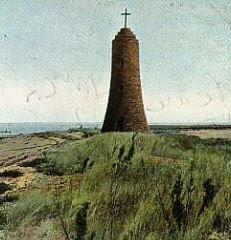Annotation:Lucky Scaup: Difference between revisions
No edit summary |
No edit summary |
||
| (3 intermediate revisions by the same user not shown) | |||
| Line 1: | Line 1: | ||
{{TuneAnnotation | {{TuneAnnotation | ||
|f_annotation='''LUCKY SCAUP.''' Scottish, Reel (4/4 time). D Major. Standard tuning (fiddle). AAB. Lucky Scaup (or, sometimes, Lucky Scalp) was a tower or folly built in the estuary off The Shore also known as the Moors (today it is referred to as Tayport Beach) in Fife, Scotland, across from Dundee. This Scottish stone tower was built by Admiral Dougall in 1861 and was used as a marker for ships in the North Sea looking for safe haven. It became unstable and was demolished in 1979. The tune was composed by accordion player and bandleader Jimmy Shand with Bert Shorthouse. | |f_annotation=[[File:Luckyscaup.jpg|right|400px|thumb|Lucky Scaup]]'''LUCKY SCAUP.''' Scottish, Reel (4/4 time). D Major. Standard tuning (fiddle). AAB. Lucky Scaup (or, sometimes, Lucky Scalp) was a tower or folly built in the estuary off The Shore also known as the Moors (today it is referred to as Tayport Beach) in Fife, Scotland, across from Dundee Lucky Scalp beacon near the mouth of the river Tay. This Scottish stone tower was built by Admiral Dougall in 1861 and was used as a marker for ships in the North Sea looking for safe haven and was the site of a salmon fishing station. It became unstable and was demolished in 1979. The tune was composed by Scottish accordion player and bandleader Jimmy Shand (1908-2000) with Bert Shorthouse; the original title being spelled SCAP which may phonetically reflect the local dialect. | ||
|f_recorded_sources=Parlophone F3413 (78 RPM), Jimmy Shand (1950) | |f_recorded_sources=Parlophone F3413 (78 RPM), Jimmy Shand (1950) | ||
|f_see_also_listing=Hear Jimmy Shand's recording on youtube.com [https://www.youtube.com/watch?v=pAMjeAXyQUw]<br> | |f_see_also_listing=Hear Jimmy Shand's recording on youtube.com [https://www.youtube.com/watch?v=pAMjeAXyQUw]<br> | ||
}} | }} | ||
Latest revision as of 16:40, 10 May 2024
X:1 T:Lucky Scaup N:Jimmy Shand M:4/4 L:1/8 D:Parlophone F3413 (78 RPM) Z:AK/Fiddler's Companion K:D D2 DF E2 EG|F2 FA G2 GB|A2F2 GFED|F2E2E2F2| D2 DF E2 EG|F2 FA G2 GB|A2A2 GFED |F2D2D2:| fg|a2d2b2d2|a2 gf g2 fg|a2d2 bagf|g2e2e2fg| a2d2b2d2|a2 gf g2 fe|A2a2 gfed|f2d2d2fg| a2d2b2d2|a2 gf g2 fg|a2d2 bagf|g2e2e2f2| D2 DF E2 EG|F2 FA|G2 GB|A2a2 gfed|f2d2d2||


